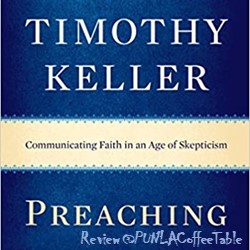written by Kip Wehrman (06/02/2023)
Episode 23V09 – Faith and Reason (Book Review)
Hello my friends. Thanks for joining me today for an @ the PUNLA coffee table. I would like to share with you a book I read by Ronald Nash “Faith and Reason”. I to share this with you as a potential resource that at least some of you might be interested in.
Let’s pray.
Okay the book is titled “Faith and Reason” by Ronald Nash. Dr. Nash states the purpose of his book is to both introduce readers to some questions linking philosophy and religion and offer some answers. The main questions Nash reviews are Christian world-view, rational thought in religious belief, does God’s exist, evil and miracles. These question encompass the vast majority of philosophical thought about religion. Nash proposes throughout the book, that Christians can rely on rational thought, reason, and philosophy to support their Christian world-view.
The Story
Dr. Nash divides his book into six parts; (1) The Christian World-View, (2) The Rationality of Religious Belief, (3) Some Arguments for God’s Existence, (4) The Problem of Evil, (5) Miracles, and (6) Conclusion. Dr. Nash states in his introduction that he had two major purposes in writing this book. The first was to introduce readers in an elementary way to some of the more important questions linking philosophy and religion. The second was to offer answers to, at least, most of them. He has a great phrase in his introduction, “If some readers find these answers unacceptable, that’s fine; this is what philosophy is all about.” Nash uses the introduction to explain and define Christian apologetics, philosophy of religion, and burden of proof which will be used throughout the arguments in the book.
Part I, The Christian World-View, includes three chapters; What is a World-View, The Christian World-View, and How to Choose a World-View.
Chapter 2, “What is a World-View,” Nash begins this chapter by defining what a noetic structure is. “A person’s noetic structure is the sum total of everything that person believes.” Nash builds on this characterizing that a noetic structure depends on how the beliefs are related, certainty about those beliefs, and how the beliefs influence or control other beliefs within the noetic structure of a person. Therefore, a person’s world-view is a smaller set of these beliefs within a person’s noetic structure. Nash includes discussions about Christian Theism as a world-view with its presuppositions and theoretical foundational thoughts. Nash concludes chapter 2 by summing up the major elements of a world-view which are; theology, metaphysics, epistemology, ethics, and anthropology, along with other questions and qualifications. Nash says, “World-views are double-edged swords. An inadequate conceptual scheme can, like improper eyeglasses, hinder our efforts to understand God, the world, and ourselves.”
In Chapter 3, The Christian World-View, Nash defines in more detail the components of the Christian world-view using theology, metaphysics, epistemology, ethics, and anthropology. Nash expands on this by describing the ultimate presupposition as defined by God’s existence as it is revealed in the Scriptures. Nash contrasts the Christian world-view against the naturalist world-view in this chapter. He stresses how important it is to fully develop a person’s worldview, such that we understand our basis for being, God’s existence, morality, knowledge and what in fact is the ultimate reality.
In Chapter 4, How to Choose a World-View, Nash breaks down the ways a person can select a world-view based on reason. Nash purposes ways to test any world-view using both reason and experience. Another such test that Nash discusses is the “outer world” and “inner world” perspectives. The “outer world” being what we experience in the world and the “inner world” being what we know about ourselves. Another test Nash discusses is “theory and practice.” Theory is essentially everything included in the reason/experience and inner world/outer world tests. Practice is simply testing if a person “can practice what they believe in their daily lives.” In the last part of this chapter, Nash highlights three issues that any test of a world-view must consider, deductive presuppositions, inductive presuppositions, and the problem of certainty. He concludes by admitting the problems with these approaches and that they must be viewed in terms of probability rather than certainty.
Part II is titled The Rationality of Religious Belief includes three chapters; The Evidentialist Challenge to Religious Belief, Foundationalism and the Rationality of Religious Belief, and What About Natural Theology.
In Chapter 5, The Evidentialist Challenge to Religious Belief, Nash defines what evidentialism as well as Plantinga’s rejection of evidentialism. Afterwards, Nash goes into more detail by asking and answering two questions; (1) What does Evidence mean?; and (2) What does Rationality mean? Nash states that Christian apologists put themselves at a disadvantage if they attempt to prove indisputable evidential proof of their beliefs. Instead, Nash proposes that apologists hold to their “epistemic rights in believing that God exists.”
In Chapter 6, Foundationalism and the Rationality of Religious Belief, Nash begins by defining foundationalism as “a particular model or picture of human knowledge.” He describes two kinds of foundationalism; narrow foundationalism and broad foundationalism. Narrow foundationalism insists that only beliefs that satisfy specific criteria form a rational noetic structure. Broad foundationalism agrees that there are distinctions between basic beliefs and non-basic beliefs, and non-basic beliefs depend in some way on basic beliefs. Nash discusses two objectives to narrow foundationalism, as well as Plantinga’s alternative to narrow foundationalism. Nash concludes that Plantinga’s work should be seen as negative apologetic.
In Chapter 7, What About Natural Theology, Nash begins by defining natural theology as “an attempt to discover arguments that will prove or otherwise warrant for belief In God.” Nash concludes that the rationality of a belief in God does not depend on the any irrefutable argument.
Part III is titled Some Arguments for God’s Existence includes five chapters; On Proving that God Exists, Cosmological Arguments for God’s Existence, The Teleological Argument, Religious Experience, and A Potpourri of Other Arguments.
In Chapter 8, On Proving that God Exists, Nash begins by defining what proof is, then expands on what is good proof and why proofs fail. Nash also promotes the value of both deductive and inductive proofs. “When major features of the inner and outer worlds cannot be given adequate scientific explanation, we will have to give added weight to a personal explanation that does explain them.”
In Chapter 9, Cosmological Arguments for God’s Existence, Nash discusses the classical arguments of God as the temporal first cause and logical first cause. Nash expands on these classical arguments with the principle of sufficient reason, contingent & necessary being. He concludes no theist should be ashamed that our belief in God is rationally and properly basic to our world-view.
In Chapter 10, The Teleological Argument, Nash defines the teleological argument as focused on certain features of the world which show order and design. Nash outlines the three primary objections to the teleological argument. Nash warns that the teleological argument does not prove the existence of God by apparent design and purpose. Christians should however recognize the importance this argument means to the belief in God.
In Chapter 11, Religious Experience, Nash discusses arguments for and against the religious experience as proof of God’s existence. Nash believes we should be careful not to separate our religious experiences from other experience, but we should however treat this argument with respect as Christians.
In Chapter 12, A Potpourri of Other Arguments, Nash discusses additional arguments for the existence of God such as, the moral, the truth, and the idea of God arguments.
Part IV is titled The Problem of Evil includes three chapters; The Deductive Problem of Evil, The Inductive Problem with Evil, and The Problem of Gratuitous Evil.
In Chapter 13, The Deductive Problem of Evil, Nash begins by defining two kinds of evil; moral evil and natural evil. Among other arguments Nash discusses the Omnipotent which is can God do absolutely anything. Nash concludes that the deductive problem of evil as an attempt to uncover a logical contradiction in theism, “must be judged a failure.”
In Chapter 14, The Inductive Problem with Evil, concentrates on the issue of free will as it is related to evil. Nash concludes that “creating morally free creatures than putting them in a challenging environment provides opportunity for soul-making.”
In Chapter 15, The Problem of Gratuitous Evil, Nash outlines three formulations about gratuitous evil; inductive formulation, deductive formulation, and meticulous providence Nash concludes that theist may have to concede a sort of stalemate when it comes to using the presence of gratuitous evil when defending a Christian world-view.
Part V is titled Miracles and includes four chapters; David Hume’s Attack on Miracles, Other Questions About Miracles, World-Views and Miracles, and Two Indispensable Miracles.
In Chapter 16, David Hume’s Attack on Miracles, Nash exposes and refutes each of David Hume’s arguments against miracles.
In Chapter 17, Other Questions About Miracles, Nash discussing two arguments among others; God versus the laws of nature, and coincidence versus miracle.
In Chapter 18, World-Views and Miracles, Nash contrasts the naturalism and Christian world-view of miracles. Nash provides a critical case against the naturalist perspective and shows ways their rational thought fails to dismiss miracles.
In Chapter 19, Two Indispensable Miracles, Nash concentrates on two miracles, the incarnation and the resurrection. Nash concludes after careful consideration of that philosophically and scientifically there is no reason miracles cannot happen. Nash says unequivocally, that based on evidence miracles like the incarnation and resurrection are actual.
Part VI is titled Conclusion includes only one chapter; Unfinished Business.
In his final chapter, Nash discusses life after death among other topics. Nash concludes how a properly formed world-view provides a conceptual system for looking at God, self and the world.
Strengths and Weaknesses
This book does a good job of laying out the arguments for major philosophical challenges to our Christian world-view and religious perspectives. A book like this is very good at giving a high level overarching review of the major arguments and possible reasonable responses to those arguments. The obvious weakness of this book is it is intentionally slanted to support the Christian world-view. However, that was the stated purpose that Dr. Nash put forward at the beginning of the book.
Practical Applicability
I greatly appreciated the arguments Dr. Nash presented in this book. This book is an excellent entry level Christian philosophy book. The book provides arguments and counter arguments for arguably the most significant philosophical questions used against Christianity. I believe the average Churchgoers would be greatly benefited by reading this book or others like it.
Let’s Pray.
I personally found Dr. Nash’s book very educational. The book provided useful information from a Christian philosopher’s perspective on several important subjects. I am appreciative of the content of this book and its organization. Dr. Nash’s logical presentation was easy to follow. I would recommend this book to anyone interested in understanding what the Christian world-view is and how that world-view addresses God’s existence, evil, miracles and rationality. The book could be used as a reference book for spot reading or as an excellent Christian apologetics text. I plan to keep this book in my personal library for future reference. I really liked how Nash defined world-view and the importance of forming a complete and rational world-view. The quintessential question is “our faith a rational faith.”
Thank you for joining me @ the PUNLA Coffee Table today, I hope you’ll join us again.
If you liked the message, please share the link with a friend. Send me comments, my email should be on the screen.
Until next time @ the PUNLA Coffee Table. God bless.


